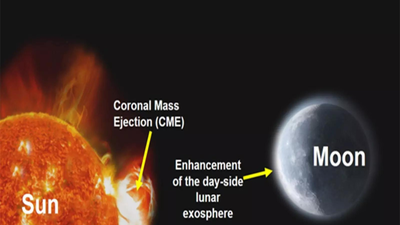
NEW DELHI: In a remarkable scientific achievement, India’s Chandrayaan-2 lunar orbiter has made the first-ever observation of the effects of the Sun’s Coronal Mass Ejection (CME) on the Moon, the Indian Space Research Organisation (ISRO) said on Saturday.The finding was made using Chandra’s Atmospheric Composition Explorer-2 (CHACE-2), one of the scientific instruments onboard the orbiter. The observations showed a significant increase in the total pressure of the Moon’s dayside exosphere or its extremely thin atmosphere, when a CME impacted the lunar surface.According to ISRO, the total number of neutral atoms and molecules, known as “number density” increased by more than an order of magnitude during this event. This confirmed long-standing theoretical models that had predicted such an effect but had never been directly observed before.
“This increase is consistent with earlier theoretical models, which predicted such an effect, but CHACE-2 onboard Chandrayaan-2 has observed it for the first time,” the space agency said in its statement.What is a Coronal Mass Ejection (CME)?A Coronal Mass Ejection is a massive burst of plasma and magnetic field from the Sun’s corona, its outer atmosphere that ejects high-energy particles, mainly Hydrogen and Helium ions, into space. When such emissions reach planetary bodies, they can affect their atmospheres and surfaces.For Earth, its magnetic field offers a layer of protection against these effects. However, the Moon has no atmosphere or global magnetic field, making it highly exposed to the Sun’s activity.A rare opportunity for observationThe rare observation occurred on May 10 last year when a series of CMEs were hurled from the Sun toward the Moon. This powerful solar activity caused atoms on the lunar surface to be knocked off and released into the Moon’s exosphere, temporarily increasing its density and pressure.ISRO said this direct observation offers valuable insights into how solar activity influences the Moon’s environment, knowledge that could prove crucial as humans plan to build future lunar habitats and scientific bases.ISRO highlighted that such extreme solar events can temporarily alter the lunar environment, posing potential challenges for establishing long-term bases on the Moon. Background: The Chandrayaan-2 missionLaunched on July 22, 2019, from Sriharikota aboard the GSLV-MkIII-M1 rocket, Chandrayaan-2 is India’s second lunar exploration mission. The mission carried eight scientific payloads to study the Moon’s surface, atmosphere and mineral composition.While the Vikram lander lost communication during its September 7, 2019, landing attempt, the Orbiter remains fully functional and continues to orbit the Moon at an altitude of around 100 km. It has been conducting valuable scientific observations for over five years.The CHACE-2 payload, part of the orbiter’s suite of instruments, is specifically designed to study the composition and variability of the lunar exosphere.This first-of-its-kind observation not only enhances scientific understanding of space weather and its effects on the Moon but also has broader implications for future lunar missions.






